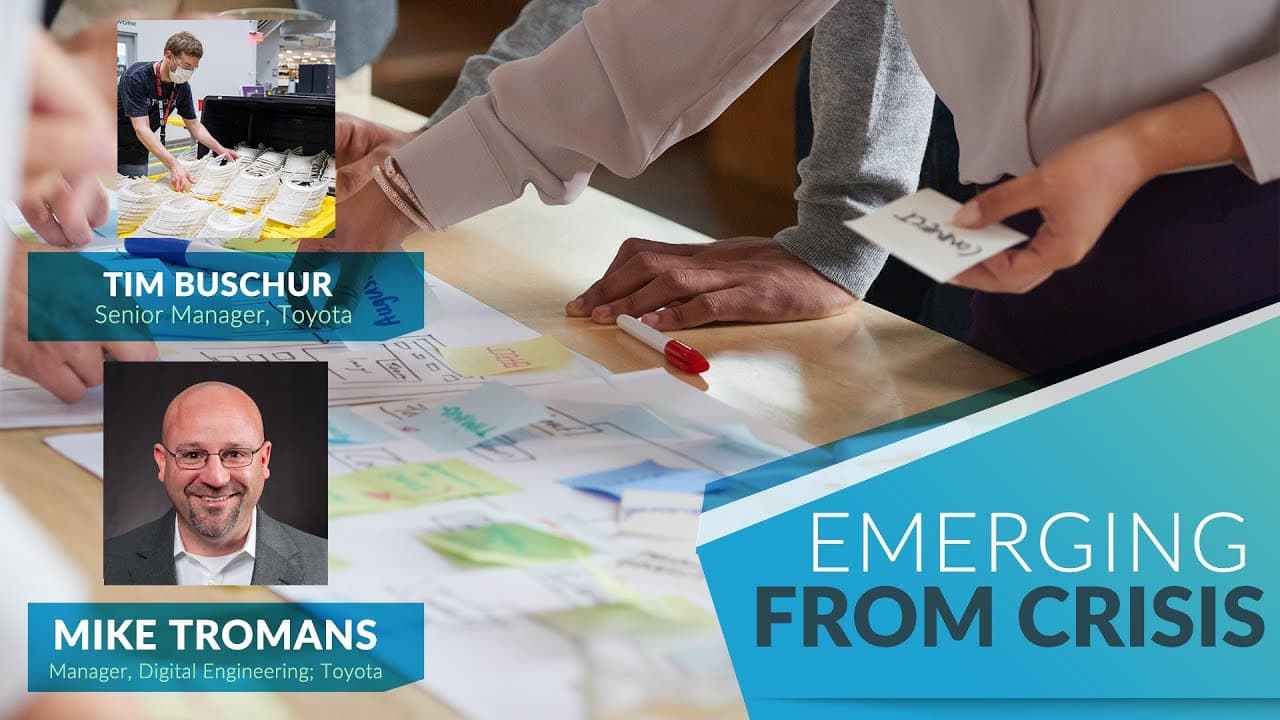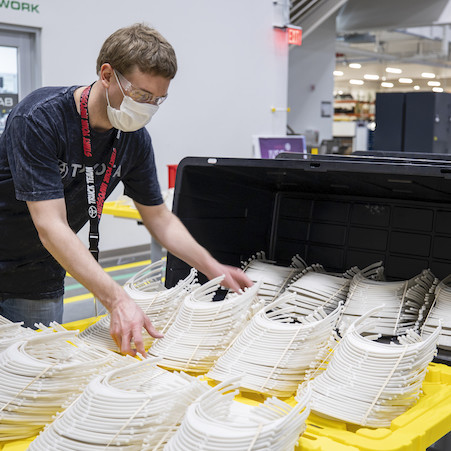Mike Tromans: I am Mike Tromans, and we're going to talk to you today about being fast and flexible at Toyota.
Tim Buschur: Hi, I'm Tim Buschur. I also work in Production Engineering, and before we jump into our story, let's watch this video to see what Production Engineering does for Toyota.
What is Production Engineering?
Production Engineering is a division that embodies creativity and ingenuity. The gear in our logo represents the driving force of innovation within our manufacturing processes, while the surrounding circles represent the priorities we challenge ourselves to achieve through internal and customer collaboration. PE defines our identity—the passion of our people, their drive for success, and our unique attitude.
In Production Engineering, we don’t design the cars, and we don’t build the cars. But we design and build the assembly lines, machines, and factories that do. We are the bridge between research and development (R&D) and manufacturing. With 1,200 team members spread across North America, we lead new model introductions to all 14 of our manufacturing sites, retooling the assembly lines for production.
Our work follows a structured job flow during pre-production, beginning with simultaneous engineering. We partner with vehicle styling and R&D to ensure the safety and feasibility of mass-producing a new vehicle while maintaining sustainable quality and competitive costs. We then move into process planning, where we combine digital information from the factory floor with new vehicle design data to determine what new equipment is needed, what can be reused, and what requires modification.
With a clear process plan in place, we proceed to the equipment procurement phase, partnering with suppliers to design and build the necessary equipment. Once the equipment is ready, we prepare the manufacturing site for installation, working closely with third-party installers while adhering to strict safety guidelines.
Next, we conduct line trials, executing multiple cycles to confirm safety, quality, and productivity. Finally, we support the new model launch, surfacing and resolving any problems that arise during high-volume production.
Beyond new model introductions, PE also manages life cycle projects, supporting major facility refurbishments and continuously innovating through new technology to improve our vehicles, manufacturing processes, and engineering methods.
Digital Engineering & Agile Adoption
Tim: Hey Mike, can you tell them more about your work?
Mike: I’m in Digital Engineering, and we’ve been using Scrum for the past four years to deliver software applications for Production Engineering. What does that mean? We build business applications to help our production engineers, who are spread across North America, do their jobs more effectively. We automate processes and try to eliminate administrative burdens so they can focus on value-added work—making our cars better and more cost-efficient for our end customers.
But what about you, Tim? What do you do here?
Tim: I'm the table leg. I'm just part of the support structure. But seriously, I lead the TILT Lab, an awesome part of Production Engineering focused on accelerating the adoption of new technology and exploring the value proposition of Industry 4.0 technologies.
The TILT Lab & Business Agility
The creation of the TILT Lab itself is an interesting story, but the main point is that we focus on speeding up our business, solving tough problems, and leveraging business agility as the solution. This leads us to today’s story—an exercise in resilience and faster learning cycles.
Located at our engineering headquarters in Georgetown, Kentucky, the TILT Lab consists of multiple studios:
- 3D Printing & Additive Studio – Featuring state-of-the-art printers.
- Design & Software Studio – For engineers to experiment with cutting-edge design equipment and software.
- Electronics Studio – To build first hardware prototypes.
- Robotics & Mixed Reality Space
- Fabrication Studio – Allowing us to bring our hardware prototypes to life.
The most important element of the TILT Lab is the dozen team members working there every day. Over the past four years, they have embodied active teamwork and rapid learning cycles, developing resilience that allowed them to respond quickly to unique challenges—such as those posed by COVID-19.
3D Printing & Medical Face Shield Production
One of our team members, Dallas, proposed an idea at the start of the COVID-19 crisis—using our 3D printers to support our customers and communities by printing medical equipment. His idea was to partner with Stratasys, a leading additive manufacturing company and close Toyota business partner. Stratasys had formed a corporate coalition to use 3D printers for face shield production.
Dallas went from idea to prototype in just one day. The TILT Lab team quickly iterated on the first designs, overcoming initial friction and resistance. Within three weeks, we progressed from 3D-printed face shields to medium-volume plastic injection molding. Normally, this process takes Toyota 8 to 12 weeks, but by leveraging our team’s resilience and Production Engineering expertise, we compressed it to three weeks.
Scaling Production & Software Support
Mike: Early in the production process, I saw an internal email about Tim’s team producing medical equipment. I reached out to ask if our software team could help. Tim’s team was facing a critical challenge: as they scaled from a few hundred face shields per day to 3,000–5,000 per day, they lacked a way to track orders and shipments.
Within 48 hours, my team developed a minimal viable product (MVP)—a simple website that allowed them to receive orders and track shipments. We launched the site and issued daily updates based on feedback from the team.
Tim: We were focused on ramping up production, but our paper Kanban method was about to fail us at 10,000 units per day. Mike’s team saved the day with their web application, providing visibility from order intake to shipment tracking.
Scaling Up to 30,000 Units Per Day
Tim’s team collaborated with our communications group to refine the face shield design based on customer feedback. They rapidly increased production capacity through multiple phases:
- Initially attempted scaling with a 3D-printed mold insert for injection molding.
- Quickly pivoted to CNC milling a metal injection mold, producing three parts per shot.
- Further increased efficiency by developing a 12-void mold, producing 12 face shields per shot.
As shipments scaled up, we encountered another challenge—tracking deliveries. We built a Power BI dashboard to visualize order statuses and shipping data. Within the first 10 days, we had processed 240,000 orders across 20 different states.
Final Results & Impact
In total, we shipped 448,000 face shields to 225 organizations in 32 states. This was made possible by active teamwork, an agile framework, and Mike’s team’s web application.
Tim: Toyota excels in agility on the factory floor, but corporate functions can be less nimble. The teamwork we saw during the COVID-19 response was inspiring. Harnessing that energy through Scrum to produce tangible results was amazing and opened our eyes to new possibilities.
Mike: What stood out was that this project wasn’t driven by top-down directives. It was a group of passionate people coming together to do what needed to be done. Seeing the emotional response from customers receiving the face shields made it all worth it.
Thanks for listening, and have a great day!





